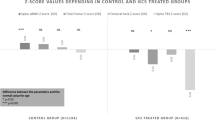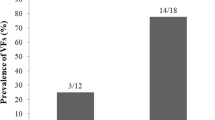Abstract
Summary
We examined bone densitometric data in a four-year follow-up period before and after the cure of CS. Plasma cortisol concentrations were similar, but the duration of estimated glucocorticoid excess was longer in patients with prevalent bone fractures compared to those without fractures. After therapy of CS, bone area, BMC and BMD increased significantly at the LS and femur during follow-up, but they decreased at the forearm, suggesting redistribution of bone minerals from the peripheral to the axial skeleton.
Introduction
Only a few studies report the changes in bone mineral density (BMD) after the cure of Cushing’s syndrome (CS).
Methods
Forty-one patients with Cushing’s disease, 21 patients with adrenal CS and 6 patients with ectopic CS were prospectively enrolled. BMD, bone mineral content (BMC) and bone area were measured by DXA.
Results
No significant correlations were found between serum cortisol concentrations and baseline bone densitometric data. After successful therapy of CS, bone area and BMD increased significantly at the lumbar spine (LS) and femur during follow-up, but they decreased at the forearm. The progressive increase in BMC at the LS had a significant negative correlation with the change of the BMC of radius in the first and second follow-up years. The change in the body mass index was an independent predictor for changes in BMC both at the LS and at the forearm at the second year of remission.
Conclusions
The regional differences and the time-dependent changes of BMC suggest that the source of marked increase in axial BMC after the cure of CS is, at least partly, due to the redistribution of bone minerals from the peripheral to the axial skeleton.

Similar content being viewed by others
References
Hermus AR, Smals AG, Swinkels LM et al (1995) Bone mineral density and bone turnover before and after surgical cure of Cushing’s syndrome. J Clin Endocrinol Metab 80:2859–2865
Stepán J, Weiss V, Marek J et al (1997) Spontaneous remission of corticosteroid osteopenia after successful surgical treatment of Cushing’s syndrome. A cross-sectional study. [Article in Czech, abstract in English] Cas Lek Cesk 136:464–467
Luisetto G, Zangari M, Camozzi V et al (2001) Recovery of bone mineral density after surgical cure, but not by ketoconazole treatment, in Cushing’s syndrome. Osteoporos Int 12:956–960
Di Somma C, Pivonello R, Loche S et al (2002) Severe impairment of bone mass and turnover in Cushing’s disease: comparison between childhood-onset and adulthood-onset disease. Clin Endocrinol (Oxf) 56:153–158
Francucci CM, Pantanetti P, Garrapa GG et al (2002) Bone metabolism and mass in women with Cushing’s syndrome and adrenal incidentaloma. Clin Endocrinol (Oxf) 57:587–593
Di Somma C, Pivonello R, Loche S et al (2003) Effect of 2 years of cortisol normalization on the impaired bone mass and turnover in adolescent and adult patients with Cushing’s disease: a prospective study. Clin Endocrinol (Oxf) 58:302–308
Ohmori N, Nomura K, Ohmori K et al (2003) Osteoporosis is more prevalent in adrenal than in pituitary Cushing’s syndrome. Endocr J 50:1–7
Karavitaki N, Ioannidis G, Giannakopoulos F et al (2004) Evaluation of bone mineral density of the peripheral skeleton in pre- and postmenopausal women with newly diagnosed endogenous Cushing’s syndrome. Clin Endocrinol (Oxf) 60:264–270
Minetto M, Reimondo G, Osella G et al (2004) Bone loss is more severe in primary adrenal than in pituitary-dependent Cushing’s syndrome. Osteoporos Int 15:855–861
Leong GM, Abad V, Charmandari E et al (2007) Effects of child- and adolescent-onset endogenous cushing syndrome on bone mass, body composition, and growth: a 7-year prospective study into young adulthood. J Bone Miner Res 22:110–118
Tauchmanova L, Pivonello R, Di Somma C et al (2006) Bone demineralization and vertebral fractures in endogenous cortisol excess: role of disease etiology and gonadal status. J Clin Endocrinol Metab 91:1779–1784
Chiodini I, Carnevale V, Torlontano M et al (1998) Alterations of bone turnover and bone mass at different skeletal sites due to pure glucocorticoid excess: study in eumenorrheic patients with Cushing’s syndrome. J Clin Endocrinol Metab 83:1863–1867
Abad V, Chrousos GP, Reynolds JC et al (2001) Glucocorticoid excess during adolescence leads to a major persistent deficit in bone mass and an increase in central body fat. J Bone Miner Res 16:1879–1885
Scommegna S, Greening JP, Storr HL et al (2005) Bone mineral density at diagnosis and following successful treatment of pediatric Cushing’s disease. J Endocrinol Invest 28:231–235
Kristo C, Jemtland R, Ueland T et al (2006) Restoration of the coupling process and normalization of bone mass following successful treatment of endogenous Cushing’s syndrome: a prospective, long-term study. Eur J Endocrinol 154:109–118
Godang K, Ueland T, Bollerslev J (1999) Decreased bone area, bone mineral content, formative markers, and increased bone resorptive markers in endogenous Cushing’s syndrome. Eur J Endocrinol 141:126–131
Looker AC, Wahner HW, Dunn WL et al (1995) Proximal femur bone mineral levels of US adults. Osteoporos Int 5:389–409
Cortet B, Cortet C, Blanckaert F et al (2001) Quantitative ultrasound of bone and markers of bone turnover in Cushing’s syndrome. Osteoporos Int 12:117–123
Tauchmanova L, Rossi R, Nuzzo V et al (2001) Bone loss determined by quantitative ultrasonometry correlates inversely with disease activity in patients with endogenous glucocorticoid excess due to adrenal mass. Eur J Endocrinol 145:241–247
Mancini T, Doga M, Mazziotti G et al (2004) Cushing’s syndrome and bone. Pituitary 7:249–252
Vestergaard P, Lindholm J, Jorgensen JO et al (2002) Increased risk of osteoporotic fractures in patients with Cushing’s syndrome. Eur J Endocrinol 146:51–56
Author information
Authors and Affiliations
Corresponding author
Rights and permissions
About this article
Cite this article
Fütő, L., Tőke, J., Patócs, A. et al. Skeletal differences in bone mineral area and content before and after cure of endogenous Cushing’s syndrome. Osteoporos Int 19, 941–949 (2008). https://doi.org/10.1007/s00198-007-0514-x
Received:
Accepted:
Published:
Issue Date:
DOI: https://doi.org/10.1007/s00198-007-0514-x




